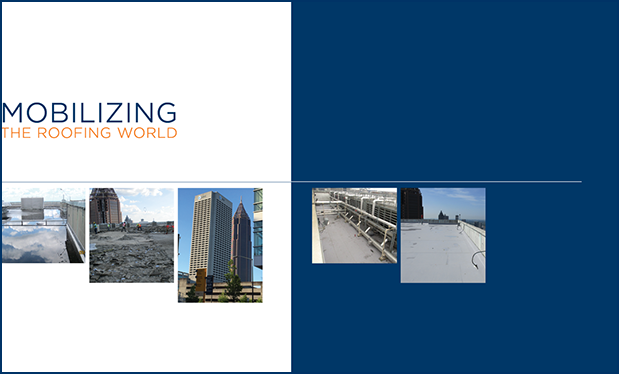Technology constantly is evolving and changing our reality. It affects our personal and professional lives, often adding efficiency and productivity.
The roofing industry has not been immune to these changes as companies use drones more frequently on construction sites, discover more advanced technology to help keep workers safe and implement estimating software, among many other things. Even artificial intelligence recently has become a topic of interest.
Since 2014, NRCA's Young Contractors Committee has held its Young Contractors Committee Roundtable Discussion: Emerging Technology in the Roofing Industry during NRCA's annual convention and the International Roofing Expo (IRE). The roundtable offers roofing professionals an opportunity to discuss how they use technology and the challenges they face, as well as an opportunity to take away some ideas they can implement at their companies.
This year's roundtable was held Feb. 6 during NRCA's 131st Annual Convention and the 2018 IRE in New Orleans. Participants discussed technology with other roofing professionals; members of the Young Contractors Committee and other NRCA member volunteers served as facilitators at the tables. The event also included a Q & A session with Chase Lecklider, president of Chase Restoration LLC, Indianapolis, and co-chairman of NRCA's Young Contractors Committee; Erica Jackson, president of CYE Enterprises, Jacksonville, Fla.; Geoff Mitchell, CEO of Mid-South Roof Systems, Forest Park, Ga.; J.J. Smithey, president of Frost Roofing Inc., Wapakoneta, Ohio; and Brad Sutter, executive vice president of Sutter Roofing Co. of Florida, Sarasota, and co-chairman of NRCA's Young Contractor Committee.
This year's session encompassed a broad range of topics; highlights follow.
Starting the conversation
One of the initial challenges regarding any technology often is getting people to implement it—some have difficulty seeing the value of investing in new technology.
"You need to communicate the why," Jackson says. "You need buy-in from the managers. It's important to have a manageable amount of change—do not try to put too much into play at one time."
Mitchell agreed, emphasizing the importance of management's commitment to technology adoption.
"If team members sense upper management is not committed to implementing a new technology, they will not follow suit," he says.
Sutter stressed the importance of having realistic expectations.
"You should offer a road map for why you need to adopt but be prepared for the reality that some people may opt out and choose to leave rather than adopt the technology," he says.
Facilitator John Embow, president of Grove Roofing Services Inc., Buffalo, N.Y., says participants at his table discussed their experiences with compliance and adoption.
"The most successful approach was that of investing upfront in a plan," Embow says. "By first training thoroughly before mandating, companies had successful adoption with fewer excuses. Others have tried less demanding approaches with less success."
Frustrations and lessons
Still, once technology is implemented, another frustration can be trying to integrate technologies on one platform. For example, companies may want to integrate GPS truck tracking with payroll systems and accounting systems, or integrate estimating software and programs with accounting systems and real-time inventory systems.
"There was a lot of discussion surrounding integrating technology and the use of several programs and applications that don't communicate," says facilitator Scott Kawulok, vice president of B & M Roofing of Colorado Inc., Frederick. "Inability to integrate technologies on one platform seemed to be frustrating for people."
Sutter agrees people want a solution that can meet all their demands.
"Attendees were using multiple systems to cover their needs," Sutter says. "Everyone is looking for the one system to connect the different pieces of roofing—but to a large extent, that doesn't exist. The people who appear to be the most satisfied with their existing systems are those who have figured out how to best integrate or connect the data. This typically is done through the import/export process of taking data produced by one system and uploading it into another system formatted to suit the purpose.
"An example of integration would be a company using remote timekeeping for its field labor and importing it into its accounting system," he continues. "That type of operation does not happen seamlessly. It typically takes an operator several steps to clean the data coming from the timekeeping system before it can be uploaded into an accounting system. This highlights the desire for a single-source system and effortless connectivity; it's great in theory but tough to get there."
Another aspect of technology attendees found frustrating was project management software.
"Two folks spent a lot of money on Prolog and Viewpoint project management software only to get rid of it later," Embow says. "They were creating steps and processes they didn't need."
The use of drones and GoPros continued to be a popular topic.
Jackson says her company uses GoPros and drones mostly for marketing but also uses them to check installation quality. Smithey says he uses the technology to present information to clients internally and as a sales tool.
"We're starting to see the use of infrared technology, but we haven't used it yet," Smithey says.
"We have a full-time staff member who uses a drone for quality control," Sutter says. "And we use a chest-mounted GoPro to document."
Social media also was part of the conversation.
"Content messaging with social media and having someone internally police that effort—posts, frequency, messaging, safety—was discussed at length," says facilitator Chad Collins, president of Bone Dry Roofing Co., Bogart, Ga.
During the panel, one attendee said it is important for companies to take control of their social media messages; for example, roofing companies often post photos on social media that do not meet Occupational Safety and Health Administration regulations.
"Your content and who you designate as the administrator is important because that is the image and face of your company," Jackson says.
An especially high-interest topic during the event was cybersecurity as cyberattacks become a growing threat in an increasingly digital world.
"The cybersecurity risks and numerous examples of people whose information has been compromised surprised me a little," Collins says. "The threat is real, and we know it exists. But I was surprised by how many people in the room had personal experience."
Facilitator Bob Morgan, CEO of Upstate Roofing and Painting Inc., Rochester, N.Y., also was surprised by some cybersecurity methods discussed.
"One hot topic was a program called Positive Pay that allows companies to track payables to avoid being scammed or breached," Morgan says. "I did not know this was a common occurrence."
The topic also was popular during the panel discussion as attendees shared what they do to combat cybertheft, including eliminating hard checks, requiring two signatures for withdrawals, investing in cybertheft security policies and researching basic cybersecurity practices.
Looking ahead
When asked what they view as the next big thing in roofing technology, facilitators had various answers.
"I see increased use of technology to reduce labor demands to accomplish work in the field," Kawulok says. "Examples of this are roof systems that are easier to install, mechanized tear-off and material handling equipment. Also, I think we will see technology, specifically Web-enabled wearable technology, employed to increase safety and monitor productivity."
Embow sees the role of drones widening.
"I see drone surveillance of jobs to monitor labor," he says.
Collins predicts there will be movement toward a smoother process.
"I see continued development and improvements around field data—field time, operations (budget to actual costing)—becoming more seamless and paperless," Collins says.
Sutter believes the future of roofing technology must be viewed from two angles—field operations and management systems.
"Regarding field operations, wearable technology for safety, job-site production and training will develop quickly," Sutter says. "We are starting to see virtual reality development for field installation of materials and details. As building modeling and 3-D plans become more common, the integration of virtual reality into actual installation will affect our part of the construction industry.
"On the management information side, there will continue to be bigger pieces of the accounting, operations, safety and tracking handled by larger systems," he continues. "As residential and commercial roofing companies continue to grow, they will require more sophisticated software and control systems to manage daily activities. As that need becomes more lucrative for companies, they will focus resources on developing enterprise level systems or one-stop software packages for contractors."
As technology evolves, possibilities emerge.
"The exciting thing about technology is there is truly something for everyone regardless of how large or small your company is," Collins says. "There are so many opportunities to use technology to improve your business as long as you know what you are trying to accomplish."
Krista Berns is NRCA's director of online communications.



